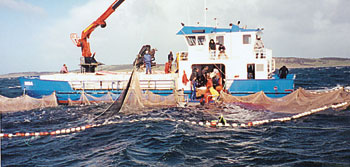Tuna Barons
by Jeff Della Penna
|
Whether you call it “penned tuna,” “farmed tuna” or the “manipulated enhancement of wild tuna,” the concept of loading a bunch of live tuna into what are basically feedlots, and then growing them out for the market, is catching on. In fact, it was only a matter of time before a penned-tuna operation was started in the Gulf of Maine.
Jerry Abrams has been involved in the Western Atlantic Tuna Fishery for years. He was the founder of East Coast Tuna Association and has represented the U.S. on numerous occasions at ICCAT (the International Convention for the Conservation of Atlantic Tunas), the governing body for the Atlantic bluefin tuna fishery. Abrams currently owns FWF Inc., out of Gloucester, Mass. His company buys and consigns bluefin tuna for the international market.
Up until now, the primary focus of penned-tuna has been in Southern Australia and the Mediterranean. Abrams says he has been approached by several groups to invest in tuna pen operations in the New England area. “In fact, there was one proposal to put a pen site in the Cape Cod bay,” Abrams recalls. “That would not have been a very good idea. The reason that I’ve always stayed away from that kind of investment is the high probability for failure. You’ve got storms that come in here and people here that are not going to want the pens in certain places. The cost just wouldn’t make it effective.”
|

A harvesting vessel removing Southern Pacific Blue Fin Tuna from pens at Port Lincoln, Southern Australia.
|
The way Abrams sees it, no one in their right mind would invest in a penned-tuna project in New England, but, last June, the National Marine Fisheries Service (NMFS) announced the receipt of a request for exempted fishing permits for tuna purse seine vessels to transfer purse-seine-caught bluefin tuna to a towed cage for the purposes of examining premature shedding of pop-up satellite tags, investigating alternative harvesting methods, and most interestingly, “gathering information on how delayed landing of purse seine captured bluefin tuna might impact market prices.”
According to Alan D. Risenhoover, Deputy Director of the Office of Sustainable Fisheries for NMFS, several operators of
continue
|
|
|
N by NW
by Mike Crowe
|
When English settlers, at Popham Beach, Maine, threw in the towel or whatever was thrown back in 1608, the trip began with the building of a ship.
After their first long winter, out of food, at odds with the native Americans and their leader dead, they decided to return to England. There was a shipwright among them, but, being the only European settlement, other than Jamestown, Virginia, in what is now the U.S., they were not going to buy the tools or the sawn lumber they needed. What they built was a 50’ “pinnace,” the first ship built in America and which they named the “Virginia.”
But all these things were not the greatest problems they would find themselves facing. For they had little knowledge of the seas they would sail and, at best, not much of a compass to guide them. On clear nights they could have sailed by the stars, days by knowledge of prevailing winds and currents. But in a storm, all these things changed.
Before the advent of the compass, other navigational tools were used, such as knowledge of the winds, currents, and the seasonal patterns of various sea animals. Norsemen sometimes used birds by carrying them on board. When they thought they were close to land, a bird was released, if it flew away, it was followed toward land. If it returned, it was assumed they were not near land.
There is evidence that the Chinese discovered that lodestone was naturally magnetic and oriented itself in a north-south direction at least as early as 84 A.D. It could also be used to magnetize metal. But the early use of the compass in China was for practicing feng shui (the science of winds and waters), a system of arranging buildings, walls, streets, etc., that they believed most benefited the people using them. For the Chinese, south was the principal direction. The “magnetic” needle is mentioned in a Chinese text, dated 1040 A.D. It describes a magnetized metal fish that was floated in a bowl of water where the fish's head pointed south.
continue
|

Isambard Kingdom Brunel (1806-59), engineer and designer of the first propeller driven,
iron-hulled steamship, the Great Britain, launched in 1843. The iron ship compounded the
problem of shipboard metal throwing off compasses. Brunel was known for his big projects –
ships, bridges, etc. It is not a coincidence that this photo finds him with giant chain links for
a background. On it’s fifth transatlantic trip, the Great Britain left Liverpool for New York.
Steaming along on a dark night it slammed into the Irish coast, a victim of its compass.
Robert Howlett photo.
|
|
  
|
|

